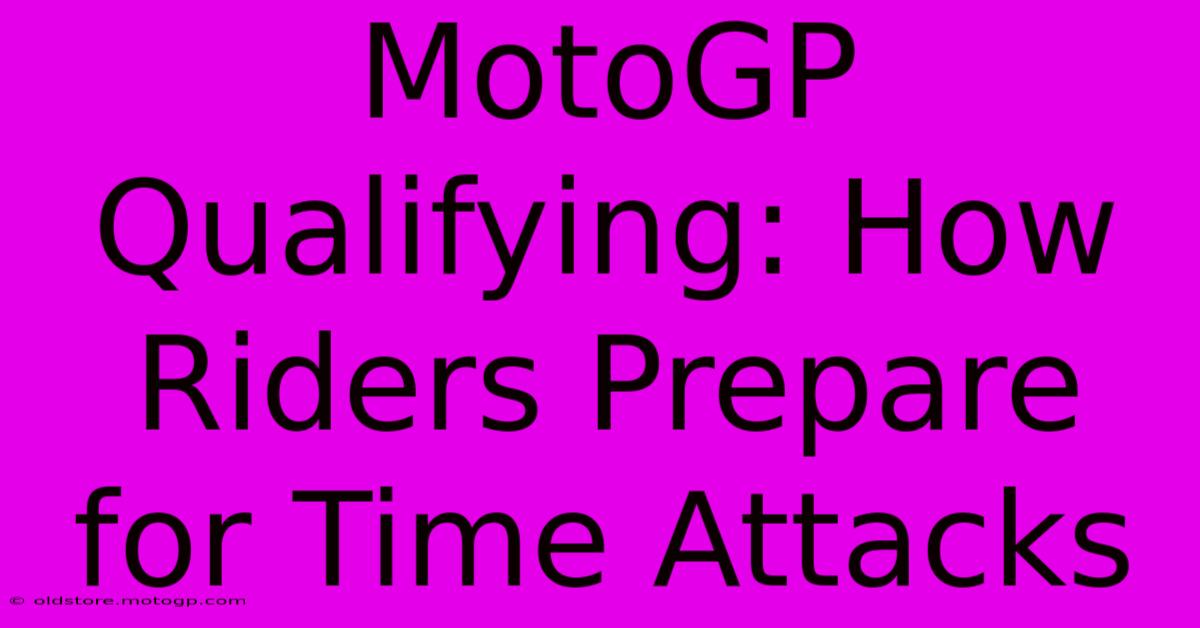MotoGP Qualifying: How Riders Prepare For Time Attacks

Table of Contents
MotoGP Qualifying: How Riders Prepare for Time Attacks
MotoGP qualifying is a high-stakes game of precision and strategy. The difference between pole position and starting further down the grid can significantly impact race results. But securing that coveted front-row spot isn't just about raw speed; it's about meticulous preparation and execution of a carefully planned time attack. This article delves into the intricate preparations MotoGP riders undertake to maximize their chances in qualifying.
The Build-Up: More Than Just Speed
Qualifying isn't a sudden burst of activity; it's the culmination of a week's worth of work. The process starts long before the riders even touch their bikes.
1. Data Analysis and Track Learning:
- Understanding the Track: Riders and their teams spend considerable time analyzing telemetry data from practice sessions. This data reveals crucial information about braking points, corner speeds, and ideal racing lines. Every millimeter counts at this level.
- Fine-Tuning the Setup: Based on the data, the team makes minute adjustments to the bike's setup. This involves tweaking suspension settings, aerodynamics, and engine mapping to optimize performance for the specific track conditions. Finding the perfect balance between stability and agility is key.
- Tire Selection Strategy: Choosing the right tires is paramount. Teams meticulously assess track temperature, grip levels, and weather forecasts to select the compounds that provide the best grip and consistency for a flying lap.
2. Physical and Mental Preparation:
- Physical Fitness: The demands of MotoGP are immense. Riders need peak physical condition to withstand the G-forces and maintain focus during a high-intensity qualifying session. This involves rigorous training regimes focused on strength, endurance, and reaction time.
- Mental Focus: Maintaining concentration is crucial. Riders employ various techniques, such as meditation or visualization, to ensure they're mentally prepared for the pressure-cooker atmosphere of qualifying. A clear mind is essential for executing a perfect lap.
- Team Communication: Open and efficient communication between the rider and the team is essential. The rider provides feedback on the bike's handling, and the team makes adjustments accordingly. This dynamic collaboration is a key ingredient in success.
The Qualifying Session: Execution is Key
The qualifying session itself is a high-pressure environment. Every detail matters, and even the smallest mistake can cost valuable time.
1. The Out Lap:
The out lap is not just about getting to the start of the timed lap; it's about warming up the tires and engine to their optimal operating temperature. Riders will carefully manage their pace, ensuring the tires are at peak performance before beginning their timed run.
2. The Flying Lap:
This is where it all comes down to execution. Riders must perfectly execute every corner, brake precisely, and maintain their concentration throughout the entire lap. Even minor imperfections can drastically affect lap time. The pressure is immense; every tenth of a second counts.
3. Utilizing the Slipstream:
In many MotoGP qualifying sessions, riders will leverage the slipstream, also known as the draft, of other motorcycles to gain a slight speed advantage on straights. This strategic maneuver can shave off crucial milliseconds.
4. Analyzing and Adapting:
After completing a timed lap, riders and their teams analyze the data to identify areas for improvement. They might adjust the bike's setup or refine their racing line based on the feedback gathered.
Beyond the Timing Screens: The Bigger Picture
Qualifying is not just about securing the best starting position; it's a crucial step in the overall race strategy. The starting position greatly influences race tactics and significantly impacts the outcome. A strong qualifying performance sets the stage for a successful race day.
In conclusion, MotoGP qualifying is a multifaceted process that combines meticulous preparation, technical expertise, and unwavering focus. From data analysis to physical and mental conditioning, every aspect contributes to a rider's success in the pursuit of pole position. The combination of strategy, skill, and teamwork is the key to unlocking a rider's full potential on race day.

Thank you for visiting our website wich cover about MotoGP Qualifying: How Riders Prepare For Time Attacks. We hope the information provided has been useful to you. Feel free to contact us if you have any questions or need further assistance. See you next time and dont miss to bookmark.
Featured Posts
-
Dominate The Track Find Your Dream Racing Motor Bike
Feb 24, 2025
-
Moto Gp Crash Today The Road To Recovery
Feb 24, 2025
-
Cota Qualifying Dont Just Qualify Dominate
Feb 24, 2025
-
Moto Gp Engines Dominating The World Of Motorcycle Racing
Feb 24, 2025
-
Lub Si Cota Tips And Tricks For Beginners
Feb 24, 2025
